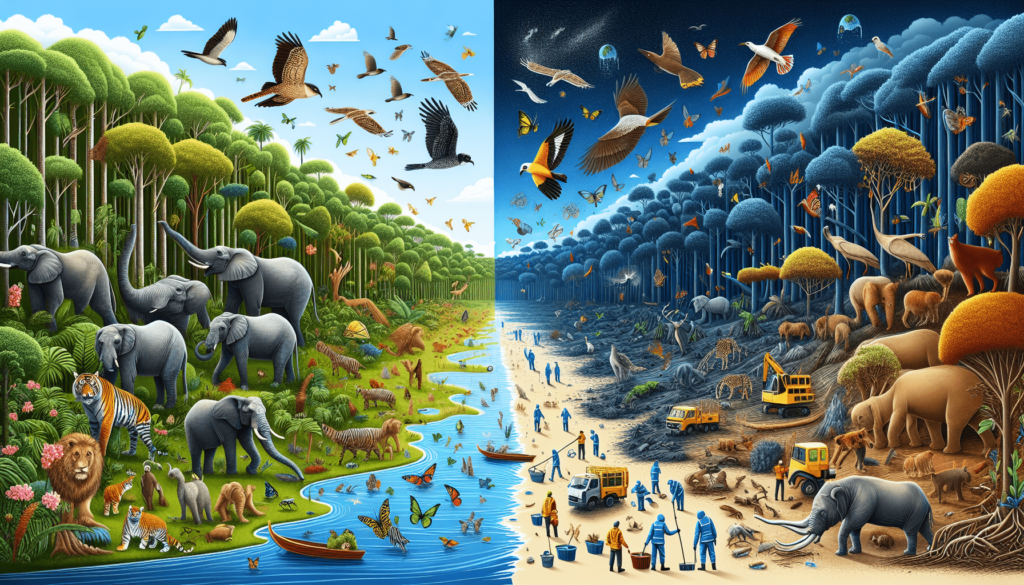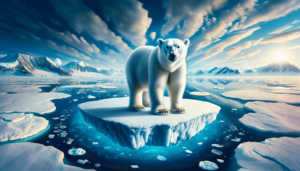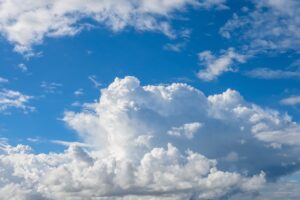Climate change is having a profound impact on our beloved wildlife and the delicate balance of biodiversity around the world. From the polar ice caps to the depths of the rainforest, this phenomenon is altering habitats, disrupting ecosystems, and posing critical challenges for a multitude of species. The consequences are far-reaching and alarming, but by understanding the ways in which climate change is affecting wildlife and biodiversity, we can take steps to mitigate its effects and protect our precious natural world.

Loss of Habitat
Changes in temperature and rainfall patterns
Climate change is leading to significant changes in temperature and rainfall patterns around the world. As temperatures rise, many habitats are becoming inhospitable for various species. Species that are adapted to specific temperature ranges are now faced with the challenge of surviving in increasingly hotter or colder environments. Similarly, altered rainfall patterns can disrupt the availability of water sources, affecting the survival and reproduction of many species.
Melting of polar ice
The melting of polar ice due to climate change is having a profound impact on wildlife and their habitats. Polar bears, for example, rely on sea ice for hunting seals, their primary food source. With the loss of sea ice, polar bears are finding it increasingly difficult to find food, leading to population declines. Additionally, the melting of ice caps is also affecting other polar species such as penguins, seals, and walruses, as their breeding and foraging grounds are being disrupted.
Ocean acidification
The increasing levels of carbon dioxide (CO2) in the atmosphere are not only causing climate change but are also leading to ocean acidification. When CO2 is absorbed by the ocean, it reacts with seawater to form carbonic acid, which lowers the pH of the ocean. This acidification can have detrimental effects on marine life, particularly on species with calcium carbonate shells and skeletons. Coral reefs, for instance, are highly sensitive to changes in pH and are already experiencing bleaching and degradation, leading to the loss of vital habitat for countless marine species.
Shifts in Species Distribution
Alteration of suitable habitats
As a result of climate change, suitable habitats for many species are shifting. With changing temperature and precipitation patterns, some areas that were once suitable for certain species are becoming less hospitable. For example, some bird species are shifting their ranges northward or to higher elevations as temperatures rise, seeking cooler environments. This alteration of suitable habitats can disrupt the natural balance of ecosystems and can result in the decline or even extinction of certain species.
Migration of species
Climate change is also causing shifts in the timing and patterns of species migration. Many migratory species rely on specific environmental cues, such as temperature and day length, to determine when to start their journeys. However, with changing climatic conditions, these cues may no longer be accurate, leading to mismatches in timing. This can have serious consequences, as it can disrupt the availability of food and nesting sites along migratory routes, negatively impacting the survival and reproductive success of migratory species.
Competition and predation
With the changing distribution of species, new interactions between species are occurring. As species migrate or occupy new habitats, they may come into direct competition with other species for resources such as food and nesting sites. This can lead to increased competition and potential displacement of native species. Additionally, changes in species distribution can also impact predator-prey relationships, as certain predators may no longer have access to their usual prey or may encounter new prey species. These shifts in competition and predation dynamics can have cascading effects throughout ecosystems.
Disruption of Ecosystems
Interconnectedness of species
Ecosystems are intricate networks of interconnected species, and any disturbance to one species can have far-reaching effects on others. Climate change is disrupting these interconnected relationships by altering the distribution, abundance, and behavior of species. For example, changes in temperature and rainfall patterns can directly or indirectly affect the availability of food sources, leading to changes in feeding behaviors and population dynamics of various species. These disruptions in the interconnectedness of species can ultimately destabilize ecosystems and jeopardize their overall functioning.
Loss of keystone species
Keystone species play a crucial role in maintaining the balance and stability of ecosystems. They have disproportionately large effects on their environment relative to their abundance. However, climate change is putting many keystone species at risk. For instance, coral reefs, often referred to as the rainforests of the ocean, are home to a vast number of species and provide essential ecosystem services. Yet, coral bleaching caused by rising sea temperatures is leading to the decline of key coral species, which in turn has cascading effects on the entire ecosystem.
Impacts on food webs
Changes in climate can disrupt the intricate web of species interactions within food webs. As the distribution and abundance of species change, the availability and composition of food sources can also be altered. For example, changes in temperature and precipitation can affect the growth and distribution of plant species, which are the foundation of many terrestrial food webs. Changes in the availability of food at different trophic levels can impact the survival and reproductive success of species throughout the entire food chain, ultimately threatening the stability of ecosystems.
Changes in Reproductive Patterns
Shifts in breeding seasons
Climate change is causing shifts in the timing of breeding seasons for many species. As temperatures warm, the onset of spring is occurring earlier in many regions, disrupting the finely tuned reproductive cycles of numerous species. For example, migratory birds that rely on a synchronized arrival of insects and flowering plants for food may find themselves out of sync, leading to reduced reproductive success. These disruptions in breeding seasons can have long-term consequences for population dynamics and the ability of species to adapt to changing conditions.
Altered timing of migration
Similar to breeding seasons, migration patterns are also being affected by climate change. Many species migrate to take advantage of seasonal fluctuations in food availability, but as the timing of these seasons shifts due to climate change, migratory patterns are becoming disrupted. This can result in decreased access to vital food sources along migratory routes and reduced survival rates for migratory species. Additionally, changes in migration timing can also impact the breeding success of species, as their ability to find suitable nesting sites and mates may be compromised.
Impacts on reproductive success
The altered reproductive patterns caused by climate change are having direct impacts on the reproductive success of many species. Increased temperatures can negatively affect reproductive organs, sperm quality, and survival rates of offspring. For example, rising temperatures can lead to increased egg mortality in reptiles and amphibians, as well as altered sex ratios in some species. These changes in reproductive success can ultimately lead to population declines and reduced genetic diversity, further exacerbating the challenges faced by species in the face of climate change.
Loss of Biodiversity
Extinction of species
Climate change is accelerating the rate of species extinction. As habitats become unsuitable or disappear entirely, many species are unable to adapt quickly enough to survive. The loss of iconic species, such as polar bears and coral reefs, is just the tip of the iceberg. Countless other species, from insects to plants, are also at risk of disappearing due to the rapidly changing climate. Each extinction has a ripple effect throughout ecosystems, leading to imbalances and further loss of biodiversity.
Reduction in genetic diversity
Climate change is not only threatening entire species but also eroding genetic diversity within populations. As habitats shrink and become fragmented, populations of species become isolated, reducing opportunities for genetic exchange. This can lead to inbreeding, reduced genetic diversity, and decreased adaptability to changing conditions. The loss of genetic diversity weakens the resilience of populations and limits their ability to respond effectively to future environmental challenges.
Decrease in species richness
The overall diversity of species within ecosystems is being impacted by climate change. With the loss of habitats and the extinction of certain species, the richness and abundance of species within ecosystems are decreasing. This decrease in species richness can lead to a simplification of ecosystems, with consequences for their overall functioning and resilience. Ecosystems with higher species richness typically exhibit higher levels of productivity, stability, and resistance to environmental stressors, making their conservation all the more imperative.
Effects on Predators and Prey
Imbalance in predator-prey relationships
Climate change can disrupt the delicate balance between predator and prey species. As the distribution and behavior of species change, the timing of predator-prey interactions can be altered. For example, if a prey species migrates or changes its range in response to climate change, predators may struggle to find alternative food sources, leading to population declines. Conversely, if predators are unable to adapt to shifts in prey distribution, their survival and reproductive success may be compromised. Imbalances in predator-prey relationships can have cascading effects throughout entire ecosystems.
Impacts on trophic cascades
Trophic cascades are ecological phenomena that occur when changes in the abundance or behavior of one species at a particular trophic level affects species at other trophic levels. Climate change has the potential to disrupt trophic cascades by altering the dynamics of species interactions within ecosystems. For example, changes in prey availability for top predators can indirectly impact lower trophic levels, leading to changes in vegetation, nutrient cycling, and overall ecosystem structure and function.
Changes in foraging behavior
Climate change can also influence the foraging behavior of predators and prey. As food sources become scarce or shift in distribution, predators may need to alter their hunting strategies or expand their range to find sufficient sustenance. Similarly, prey species may need to modify their foraging behaviors or seek refuge in new areas to avoid predation. These changes in foraging behavior can have significant implications for species survival, as they may have to adapt to new environments or face increased vulnerability to predation.
Changes in Ecosystem Services
Loss of pollination
Pollinators such as bees, butterflies, and birds play a vital role in the reproduction of many plant species. However, climate change is impacting pollination dynamics in several ways. Changes in temperature and precipitation can affect the timing and availability of flowering plants, potentially leading to mismatches between plant flowering and pollinator activity. Furthermore, shifts in species distributions can disrupt long-standing pollinator-plant relationships, reducing the efficiency of pollination and posing a threat to the reproduction of countless plant species.
Disruption of seed dispersal
Seed dispersal is essential for the regeneration and survival of plant species. Many plants rely on animals, such as birds and mammals, to disperse their seeds. However, climate change can disrupt these seed dispersal interactions. As species shift their ranges or face changes in their own abundance and behavior, the availability and effectiveness of seed dispersers can be affected. Moreover, shifts in precipitation patterns and the increased occurrence of extreme weather events can disrupt seed dispersal mechanisms, leading to reduced seed germination and the loss of plant diversity.
Altered carbon sequestration
Forests and other vegetation play a crucial role in sequestering carbon dioxide from the atmosphere, helping to mitigate climate change. However, climate change is impacting the ability of ecosystems to store carbon. Rising temperatures and changes in rainfall can influence the growth and productivity of forests, affecting their capacity for carbon sequestration. Additionally, disturbances such as wildfires, which are becoming more frequent and intense in some regions due to climate change, can release large amounts of stored carbon back into the atmosphere, further exacerbating the climate crisis.
Increased Vulnerability to Diseases
Spread of vector-borne diseases
Climate change is altering the distribution and behavior of disease vectors, such as mosquitoes and ticks, which can transmit infectious diseases to humans and wildlife. As temperatures warm, disease vectors are able to expand their ranges into previously unaffected areas. This expansion can lead to increased transmission of diseases such as malaria, Zika virus, and Lyme disease. Furthermore, changes in precipitation patterns and the availability of standing water can create more favorable conditions for the breeding and survival of disease vectors, further exacerbating the spread of vector-borne diseases.
Weakening of immune systems
Climate change can also weaken the immune systems of both humans and wildlife. Extreme heat events and prolonged droughts can increase the susceptibility of organisms to infections and diseases. Moreover, stressors associated with climate change, such as food shortages and habitat degradation, can compromise the overall health and resilience of individuals and populations. Weakened immune systems make species more vulnerable to the impacts of diseases, further threatening the survival of already stressed wildlife populations.
Impacts on population dynamics
The increased prevalence and intensity of diseases associated with climate change can have significant impacts on population dynamics. Infectious diseases can cause mortality directly or indirectly, and they can also disrupt reproductive success and reduce population growth rates. For example, epidemics among wildlife populations can lead to population crashes and local extinctions. These shifts in population dynamics can have cascading effects on entire ecosystems, altering community structures and ecosystem functioning.
Adaptation Challenges
Limited capacity for species to adapt
Climate change is happening at a faster rate than many species can adapt to through natural evolutionary processes. Populations that are already small or isolated are particularly vulnerable as they have limited genetic variation from which to draw upon for adaptation. Furthermore, many species have specific habitat requirements and are unable to rapidly shift their ranges or modify their behaviors in response to changing conditions. The limited capacity for species to adapt puts them at a heightened risk of extinction in the face of ongoing climate change.
Disruption of evolutionary processes
Climate change is disrupting the natural processes of adaptation and evolution. Rapid changes in temperature, precipitation, and other environmental variables can create novel selection pressures that species are ill-equipped to handle. Evolutionary responses typically occur over long periods of time, but current rates of climate change are outpacing the ability of many species to genetically adapt. Disruptions in evolutionary processes can have profound implications for the long-term survival and resilience of species and ecosystems.
Loss of genetic resources
The loss of biodiversity, driven in part by climate change, results in the loss of valuable genetic resources. Each species possesses unique genetic traits that have the potential to be beneficial for human well-being, such as disease resistance and agricultural productivity. As species become extinct or their populations decline, these valuable genetic resources are lost forever, diminishing our ability to respond to future challenges. Preserving genetic resources by conserving species and their habitats is crucial for maintaining the resilience and adaptability of ecosystems in the face of climate change.
Conservation and Management
Protecting and restoring habitats
Efforts to protect and restore habitats are crucial for mitigating the impacts of climate change on wildlife and biodiversity. Conserving intact habitats and creating protected areas can provide crucial refuges for species, allowing them to persist in times of environmental change. Additionally, restoring degraded habitats can enhance their resilience and ecological integrity, providing essential breeding grounds, foraging areas, and corridors for species movement. By safeguarding and restoring habitats, we can help maintain biodiversity and enable species to adapt to the challenges posed by climate change.
Enhancing connectivity
As species face the need to shift their ranges in response to changing climatic conditions, maintaining and enhancing connectivity between habitats becomes crucial. Creating wildlife corridors and establishing green infrastructure can facilitate species movement and gene flow, enabling them to track suitable habitats and migrate to new areas. Enhancing connectivity also promotes species resilience and facilitates the recolonization of habitats that have been lost or fragmented. By ensuring connectivity, we can support the long-term survival and adaptive capacity of wildlife populations in the face of climate change.
Implementing sustainable practices
Addressing climate change and its impacts on wildlife and biodiversity requires the implementation of sustainable practices across various sectors. Reducing greenhouse gas emissions is essential for mitigating climate change and preserving habitats. Transitioning to renewable energy sources, improving energy efficiency, and reducing deforestation are key steps towards a more sustainable future. Additionally, adopting sustainable agricultural practices, reducing pollution, and promoting responsible consumption can help minimize additional stressors on wildlife and ecosystems. By adopting sustainable practices, we can minimize the negative impacts of climate change and create a more resilient and biodiverse planet.
In conclusion, climate change is having profound and far-reaching effects on wildlife and biodiversity. From the loss of habitats to changes in species distributions, disruptions in ecosystems, alterations in reproductive patterns, and the loss of biodiversity, the impacts of climate change are threatening the very fabric of life on Earth. However, through conservation and management efforts that prioritize protecting and restoring habitats, enhancing connectivity, and implementing sustainable practices, we have the potential to mitigate some of these impacts and safeguard the future of our planet’s diverse ecosystems and the species that inhabit them. By embracing a collective responsibility and taking immediate action, we can create a more resilient and sustainable world for both wildlife and humanity.




